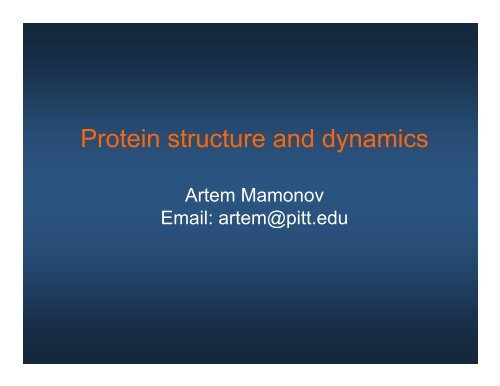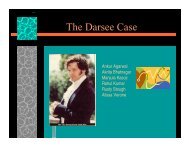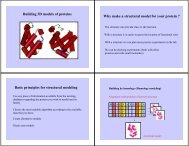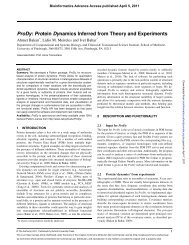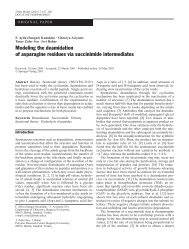Protein structure and dynamics
Protein structure and dynamics
Protein structure and dynamics
You also want an ePaper? Increase the reach of your titles
YUMPU automatically turns print PDFs into web optimized ePapers that Google loves.
<strong>Protein</strong> <strong>structure</strong> <strong>and</strong> <strong>dynamics</strong><br />
Artem Mamonov<br />
Email: artem@pitt.edu<br />
edu
Key concepts<br />
• <strong>Protein</strong>s have well defined 3D <strong>structure</strong><br />
• Structural hierarchy: from primary to tertiary<br />
•<br />
• <strong>Protein</strong>s are not static
A protein consists of a sequence of amino<br />
acids bound by peptide bonds
• Only 20 different types of<br />
amino acids are used by<br />
proteins<br />
• Bonding of amino acids in<br />
different sequences makes all<br />
the protein diversity
Definition of dihedral angles<br />
Range: -180 0 to 180 0<br />
180 0 = trans<br />
-60 0 = gauche +<br />
60 0 = gauche -<br />
0 0 = cis
Peptide chain local<br />
geometry<br />
• Peptide plane is formed by C α , C,<br />
O, N, H, C α atoms<br />
• ω angle is formed by Ca-C-N-CaC C<br />
• φ angle is formed by C-N-Ca-C<br />
• ψ angle geis formed edby N-Ca-C-N<br />
C<br />
• rotations about φ <strong>and</strong> ψ angles are<br />
the softest
The peptide plane
Local restrictions on flexibility: the<br />
Ramach<strong>and</strong>ran plot<br />
All residues<br />
Glycine<br />
The presence of chiral Ca atoms in Ala (<strong>and</strong> in all other amino acids) is responsible for<br />
The presence of chiral Ca atoms in Ala (<strong>and</strong> in all other amino acids) is responsible for<br />
the asymmetric distribution of dihedral angles in part (a), <strong>and</strong> the presence of Cb<br />
excludes the portions that are accessible in Gly.
Side chains enjoy additional degrees of<br />
freedom
Secondary <strong>structure</strong>: helixes
A closer look at Alpha-helix<br />
Helical wheel diagram
Secondary <strong>structure</strong>: β-sheets<br />
Antiparallel l β-sheeth<br />
t Parallel β-sheet
Supersecondary <strong>structure</strong>s<br />
Schematic view of a β-barrel fold formed<br />
by the combination of two Greek key<br />
motifs, shown in red <strong>and</strong> green, <strong>and</strong> the<br />
topology diagram of the Greek key motifs<br />
forming the fold (adapted from Br<strong>and</strong>en<br />
<strong>and</strong> Tooze, 1999)<br />
Only those topologies where sequentially adjacent b-str<strong>and</strong>s are antiparallel to each other are displayed. (A) 12<br />
different ways to form a four-str<strong>and</strong>ed ddb-sheet from two b-hairpins hi i (red <strong>and</strong> green), )ifh the consecutive str<strong>and</strong>s 2<br />
<strong>and</strong> 3 are assumed to be antiparallel. Not all topologies are equally probable. (j) <strong>and</strong> (l) are the most common<br />
topologies, also known as Greek key motifs; (a) is also relatively frequent; whereas (b), (c), (e), (f), (h), (i) <strong>and</strong> (k)<br />
have not been observed in known <strong>structure</strong>s (Br<strong>and</strong>en <strong>and</strong> Tooze, 1999).
[Leach]<br />
Tertiary Structure
Contact Maps Describe <strong>Protein</strong> Topologies
Dihedral angle distribution of database<br />
<strong>structure</strong>s<br />
Dots represent the observed (φ, ψ) pairs in 310 protein <strong>structure</strong>s in the<br />
Brookhaven <strong>Protein</strong> Databank (adapted from (Thornton, 1992))
The <strong>Protein</strong> Data Bank (PDB)<br />
• Electronic storage, in st<strong>and</strong>ard d format, of<br />
thous<strong>and</strong>s of protein <strong>structure</strong>s – including<br />
wild-type, mutants, t lig<strong>and</strong>-bound, d <strong>and</strong> protein-<br />
protein complexes<br />
• Freely downloadable<br />
• (x,y,z) coordinates of atoms given<br />
• Data from X-ray, NMR, modelling<br />
• http://rutgers.rcsb.org/pdb/<br />
rcsb
<strong>Protein</strong> <strong>dynamics</strong>: proteins are NOT<br />
static<br />
‣ X-ray <strong>structure</strong>s can be<br />
misleading:<br />
‣ appear static<br />
‣ subject to crystal-lattice lattice<br />
artifacts<br />
NMR PDB files often contain<br />
many <strong>structure</strong>s<br />
consistent with data<br />
1AK8.pdb (calcium-bound calmodulin)<br />
1AK8.pdb (calcium bound calmodulin)<br />
Note local fluctuations – e.g., helixfraying
Large Structural Changes<br />
Example: “induced fit” in adenylate kinase<br />
upon ATP binding<br />
[Berg]<br />
Example: re-arrangement of helices in<br />
calmodulin upon calcium binding
Large Structural Changes: Myosin<br />
[Berg]
Large Structural Changes: Allostery in<br />
Hemoglobin<br />
[Berg]<br />
Allostery example: when multiple<br />
lig<strong>and</strong>s bind with differing affinities<br />
due to a change in conformation after<br />
initial binding event(s).<br />
[Dickerson & Geis]
A movie of villin headpiece
Important mode in HIV-1 RT<br />
p66<br />
thumb<br />
fingers
How/why does a molecule l move<br />
Among the 3N-6 internal degrees of<br />
freedom, bond rotations (i.e. changes<br />
in dihedral angles) are the softest, <strong>and</strong><br />
mainly responsible for the functional<br />
motions


